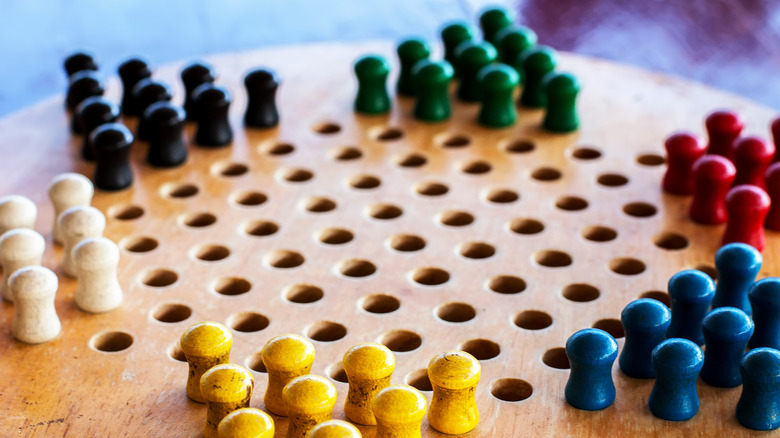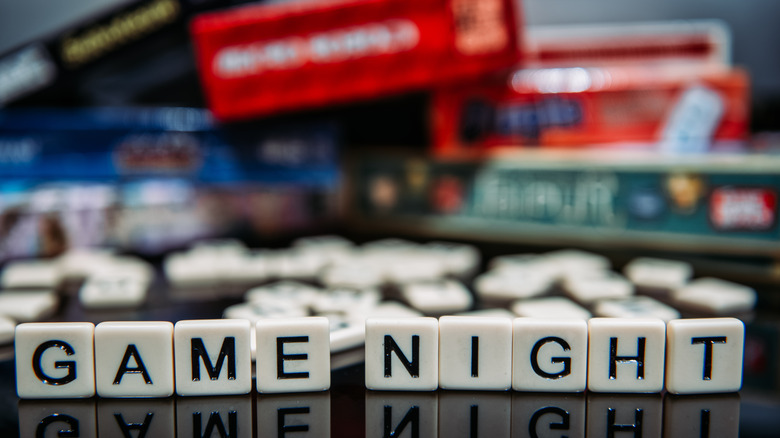The Surprising Origin Of Chinese Checkers
Have you ever played Chinese checkers? Odds are, you probably have, or at least have heard of it. The board game is fairly well-known to many people and might have been something that they played as children at one point in time. Nonetheless, not too many people know the game's surprising history.
To start, just in case you are one of the few people who have never been acquainted with Chinese checkers, we will describe the rules and how to play. Basically, each player gets 10 pegs of a color placed on the board in a triangle corner. The goal is to move all of your pegs to the opposite side of the board by hopping over other pegs (but not more than one). Unlike regular checkers, pieces are never removed, only moved elsewhere (via Masters of Games). So, with all of that in mind, where does Chinese checkers actually come from? Turns out, according to Loveland Reporter-Herald, it comes from an unlikely place: Germany.
The origin of Chinese checkers in Germany
The fact that Chinese checkers did not come from China might be a bit of a shock to some people, and it's easy to see why. After all, it's in the name itself, and it's not called German checkers. But, as the Loveland Reporter-Herald says, the board game was created in 1892 Germany and was first called "Stern-Halma" by inventors Bill and Jack Pressman. "Stern" means "star" in German, which is also the shape of the Chinese checkers board, and "Halma" is an old American board game with similarities on which the Pressmans based their invention.
Modern board games being inspired by older ones is nothing new, and even checkers borrowed influence from older games. Eventually, in 1928, the Pressman brothers both decided that their original name for the game, Hop Ching Checkers, wasn't marketable enough. That's why they came up with the idea to rebrand it as Chinese checkers, which is the name we all know today (via Plansponsor).
The game grew popular in the 1930s
A businessman by the name of L. G. Ballard saw the potential in Chinese checkers and decided to create his own variation. As stated by Kansapedia, Ballard originally had his own idea for a slight revision on Chinese checkers that he called Star checkers, which he soon began shipping out by the thousands, about 15,000 board games per month, to be exact. Ballard's experience came from selling other products like household items such as pot lifters and towel racks.
Star checkers was advertised in the Kansas Business Magazine in April 1938 and is even featured in the Kansas Museum of History. Ballard himself even made a device that helped manufacture and count marbles much more efficiently, as his version of the classic game used marbles for pieces. As said in the book "Encyclopedia of Play in Today's Society", it wouldn't be until 1941 when toy company Milton Bradley, who also made games like Life and Connect Four, patented Chinese checkers, giving them a formalized ownership of the game and its consecutive versions.
There are multiple variations of Chinese checkers
If you thought that there was only one kind of Chinese checkers in existence, you'd be wrong, as the game boasts multiple variations. It's not too implausible of a fact, considering that board game history can be pretty darn exhaustive, with many popular board games having very surprising histories. And, in the case of Chinese checkers, that's also true.
One such variation is called Rubido, which is a modern version of Chinese checkers that, unlike the original, comes with multiple difficulty settings (via "Encyclopedia of Play in Today's Society"). Another variation that exists is fast-paced Chinese checkers. This version differs from the original in that you are not bound to hop over adjacent pieces only, but can also leap farther distances, which makes the game go by a bit faster, as said by HowStuffWorks. Regardless of what one prefers, there's sure to be a version that will fit everyone's preferences.
The unfortunate racism in Chinese checkers history
While Chinese checkers may be beloved by many, there is one unfortunate aspect of it that we probably should address: racial appropriation. Given that this product was not created in China, its makers sought to make it look as ethnically Chinese as possible through the use of racial stereotypes. For starters, the original board used chop-suey font, images of dragons, and other stereotypes about China to sell itself to westerners as something exotic, as That's Mags points out.
This all dabbles in what scholars call Orientalism, which Edward Said defined in his groundbreaking book "Orientalism" as "the basic distinction between East and West as the starting point for elaborate theories, epics, novels, social descriptions, and political accounts concerning the Orient, its people, customs, mind, destiny and so on." The book goes in-depth on how stereotypes about Asia were created and perpetuated by colonialists. Chinese checkers then is a product of these same colonial biases, a relic of the past that still haunts to this day.
The game is still popular today
Chinese checkers has had a long history, many variations, and a bit of racial turbulence, but one thing still seems to ring true to this day: It's still popular around the world. WorldAtlas points out that even though the game was not created in Asia, it is still played extensively in many Asian countries, particularly in East Asia, and also enjoys popularity in Europe as well.
In fact, a version of this pastime called super Chinese checkers is actually played throughout China, and even has fans in France. This variant is faster than the original but still keeps the same rules intact (via How Stuff Works). The European alteration of super Chinese checkers, known as Anri, came about in the 1970s. This version sports simplified rules and is more suited for two-player matches, unlike the original, showing that the game has extended itself to different cultures past its origin point (via Board and Pieces). If you haven't yet experienced this popular activity, what are you waiting for?





